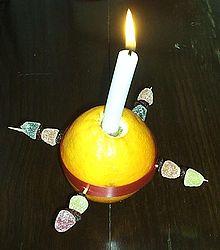- Christingle
-
A Christingle is a symbolic object, related to the pomander, used in the advent services of many Christian denominations. It has its origins in the Moravian Church.
At Christmas 1747, Germany, Bishop Johannes de Watteville thought about how he could explain the love of Jesus to everyone, and what Christmas really meant to the children in the church. He decided to make a simple symbol to express the message of Christmas in a fresh and lively way. Pastor Johannes de Watteville gave each child a lighted candle wrapped in a red ribbon, with a prayer that said "Lord Jesus, kindle a flame in these dear children's hearts". This was the first Christingle service.
Many years later, in 1968, John Pensom of The Children's Society introduced Christingle services to the Anglican Church, where the custom spread quickly. It is celebrated sometime around Christmas. Various hymns about Christingale include: The Christingle begins with an orange, We haven't come far and When the frost turns the berries red.[1]
The story of the Christingle is that there were three children, who were very poor, but wanted to give a gift to Jesus, like the other families at church were doing. The only nice thing they had was an orange, so they decided to give him that. The top was going slightly green, so the eldest cut it out, and put a candle in the hole. They thought it looked dull, so the youngest girl took her best red ribbon from her hair and attached it round the middle with toothpicks. The middle child had the idea to put a few pieces of dried fruit on the ends of the sticks. They took it to the church for the Christmas mass, and whereas the other children sneered at their meager gift, the priest took their gift and showed it as an example of true understanding of the meanings of Christmas.
The Christingle consists of:
- an orange representing the world;
- a red ribbon around it representing the blood of Jesus;
- dolly mixtures, dried fruits or sweets skewered on cocktail sticks pushed into the orange, representing the fruits of the earth and the four seasons (the representation of the four seasons was a later addition, not of Moravian origin.); and
- a lit candle pushed into the centre of the orange, representing Jesus Christ as the light of the world.[2]
The base of the candle is commonly wrapped in tinfoil. Many regard this as functional, though others ascribe it with a specific meaning.[3]
References
- ^ http://www.msgr.ca/msgr-2/christingle.htm
- ^ The Bible (New Living Translation), John chapter 8 v. 12, quote: 'I am the Light of the World, if you follow me you won't have to walk in darkness, because you will have the light that leads to life.'
- ^ Rev Kelvin Inglis of All Hallows church in Whitchurch, Hampshire, England at a service on 30 November 2008 talked about the tinfoil at the bottom of the candles as a means to "reflect Jesus' light and goodness further"; a girl in the congregation had first replied to his query about what it was for by saying it was to catch the wax drippings.
External links
Categories:
Wikimedia Foundation. 2010.

